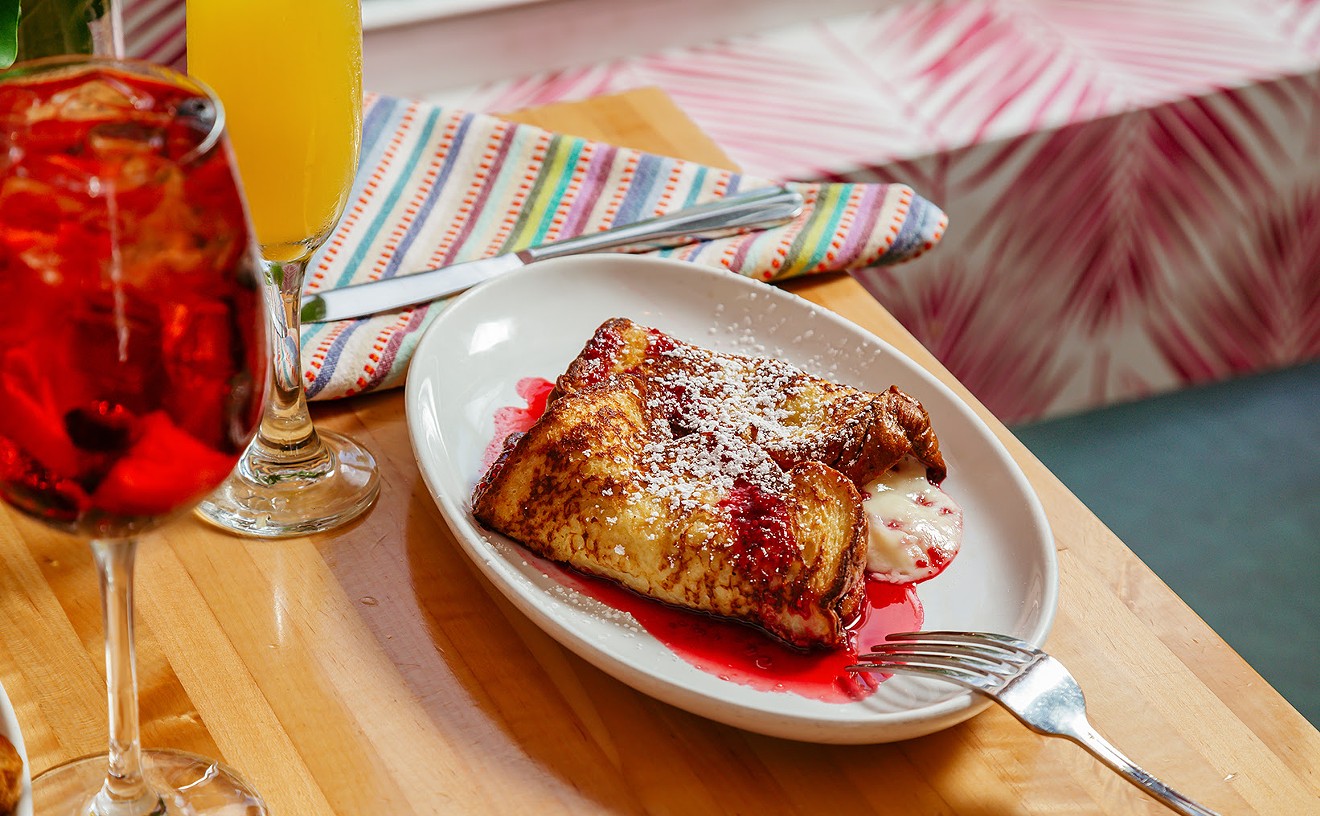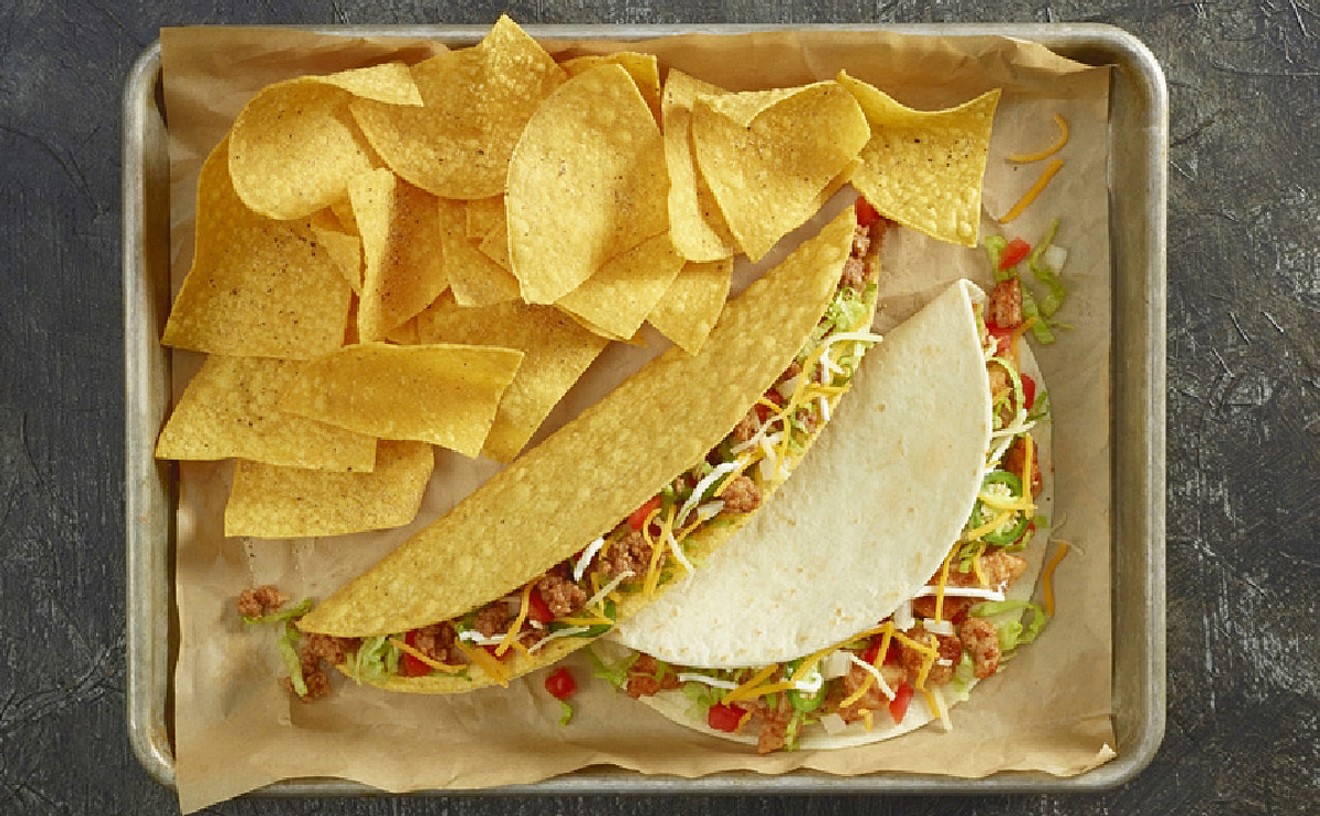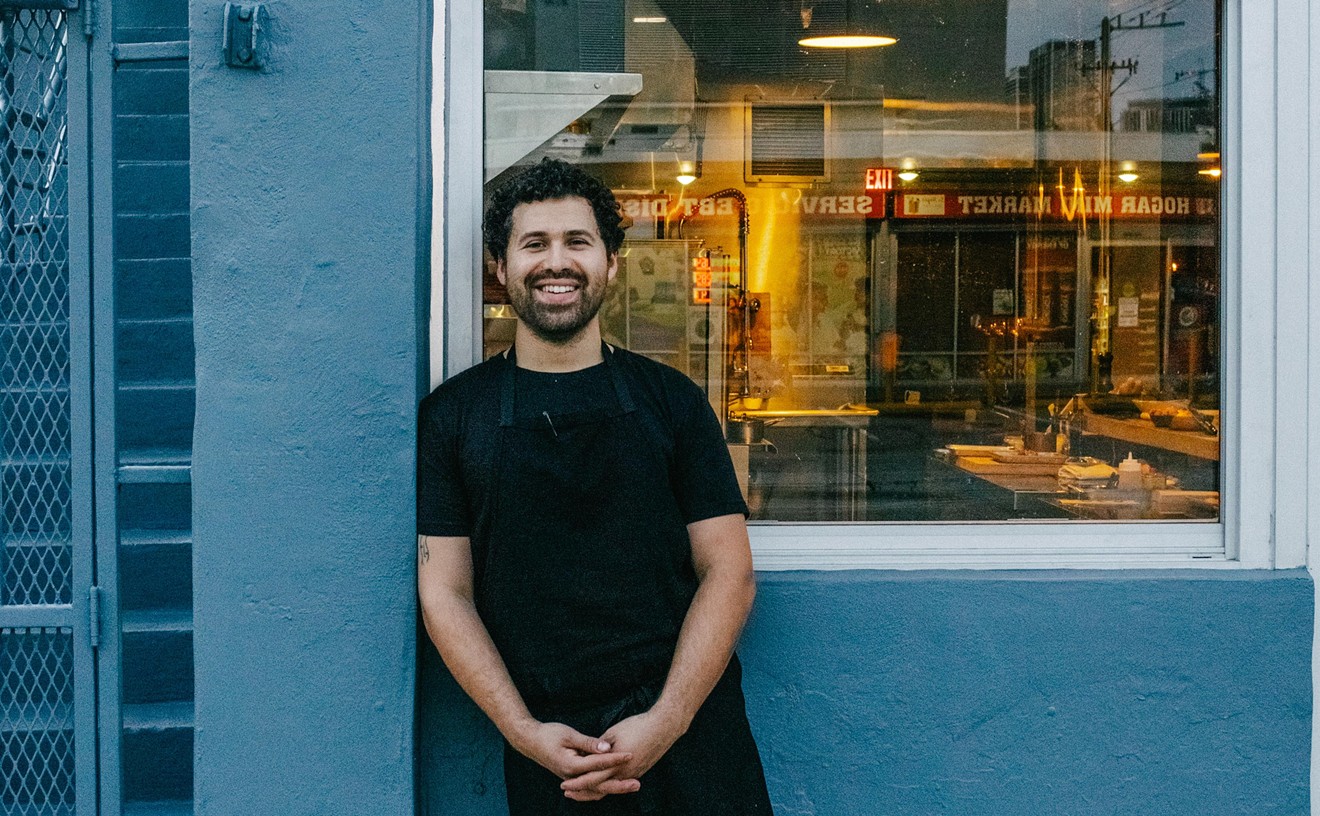Michael Psilakis (see-LAH-kees), the self-trained, 39-year-old chef behind the new Eos at Viceroy Miami, grew up in a Greek Orthodox household in East Northpoint, Long Island; his mother hails from Kalamata, his father from Crete.
Psilakis attracted an avalanche of praise for his haute Greek cuisine at Anthos in New York, and afterward with the more home-style Med meals at Kefi and Mia Dona; all were in partnership with restaurateur Donatella Arpaia. Anthos is one of just two Michelin-star Greek restaurants in existence, making Eos and Hakkasan Miami's only Michelin-related establishments — one Greek, the other Chinese. We shouldn't wait until the third turns out to be a Mexican joint in order to imprint our license plates with the motto "Weirdest Restaurant City in the World."
At Eos, Psilakis and chef de cuisine Jason Hall employ a wider lens than at Anthos; they view Greece as part of the larger Mediterranean. Because the restaurant opened in the wake of a national economic tailspin, menu ingredients were dialed down a notch from the Manhattan offerings. Even so, the bill of fare here, composed mostly of "small plates," is among Miami's most creative assemblages of comestibles.
Eos, housed on the Viceroy's 15th floor, dazzles with an interior designed by Kelly Wearstler, who is well regarded for her creative and theatrical flourishes (for instance, the faux-tortoiseshell wall inside La Marea at the Tides). The eclectic décor melds classic and Eastern aesthetics via a multihued (pink, lime green, gray, gold, and white), multitextured style that works to striking effect. An outdoor terrace with trellises is embellished by the alluring urban backdrop; it should be nice to sit out here come winter.
Hearty slices of grilled bread precede dinner. They're served with a quenelle of sun-dried tomato hummus and an addictive mascarpone-like blend of goat cheese and butter. "Crostini" adorned with assorted toppings are offered on the menu too, but because the base is a slice of the same bread just munched on, it doesn't make much sense to order these.
It's smarter to start with one or more raw fish selections, including sushi/sashimi (your choice) accented with delicate and daring accouterments such as Burrata cheese, fava beans, and caviar (with uni); and pistachio, speck, and apricots (atop nairagi). Even five fat-striped strips of normally staid salmon dazzle with petite pieces of pickled ginger, pineapple, shiso leaf, and sansho pepper (not actually a pepper but a tangy spice). These, and indeed most of Eos's cuisine, are plated in meticulously minute and stunning fashion.
Another beauty: dainty pink crab legs from New Zealand, charred corn kernels, fresh thyme, and a dab each of fig purée and yogurt arranged on the bottom of a white bowl. The waiter pours velvety chilled corn soup on top and encourages the diner to give it a stir. I can't recall a more satisfying slurp in a long, long while.
Lobster-and-sea urchin risotto also begins with an artful arrangement at bowl's bottom — a barely poached egg yolk held in place by a white moat of yogurt, with two tidbits of uni, a dab of caviar, and sprigs of fried herbs. The server then spoons warm, lobster-flavored risotto, rife with tender lobster meat, atop the ingredients and tosses it into a rich, buttery, creamy, luscious... um, did I say rich?
Much of the fare here might be described as a cappella cooking, the essence of each note soaring sans brass, strings, or truffle oil. Take the salad composed of quartered and braised artichoke hearts, strips of raw beet, diced cooked carrots, crisp English peas, pea tendrils, chives, and shavings of kefalotiri cheese. I'm not certain there was even salt applied, but the cheese chimed in with nutty, saline suggestions — and a light mist of lemon vinaigrette and olive oil quietly harmonized with the farm-fresh flavors.
Psilakis likewise shows a deconstructionist impulse to take traditional Greek and Mediterranean dishes apart and put them back together as... well, something not traditional at all. A menacing twirl of thick black smoked octopus tentacle unfurls its ferocious fire-imbued flavor under cover of sweet diced pineapple, sopressata sticks, and paper-thin ringlets of fennel — in garlic-kicked skordalia dressing. One bite and we were smitten.
This is a very versatile menu that even conjures some old-school cooking via chicken leg ballotine — which is made using a long process, the short of which is that the leg gets boned, stuffed with mousse (made of chicken meat, spices, thyme, and Sichuan pistachios), and then rolled, tied, poached in milk, and sliced. The room-temperature disks were delicious in tandem with slices of warm, crisp-skinned breast shot with black truffle purée; pickled baby corn on the side seemed too acerbic for the chicken, but proved to be a prickly palate cleanser between bites.
Spiedini "Mia Dona," a mixed grill, brought less of a thrill, though the five selections nonetheless sated by way of two petite but rich homemade lamb-based sausages (Merguez and tseftalia); quail diablo that was succulent but not devilish; a meltingly tender sweetbread nugget; and a juicy round of cheese-and-herb-rolled pork involtini. A rack of smoked, fat-streaked pork ribs proved larger in flavor and heft, the crust a brash blast of chili-coffee flavor, with an essential lime wedge on the side.
We also relished an orzo-based "Greek paella" jammed with clams, mussels, Merguez sausage, and two jumbo head-on prawns in a spectacular saffron-spiced sauce spiked with red Espelette pepper. At $14, this is an absolute steal. So are most other plates, ranging from $10 to $16. There is great variance in terms of portion size, but four or five items should suffice for a couple, and six will surely do. A handful of large main courses such as roasted rack of lamb, grilled dry-aged sirloin, and a two-pound loupe de mere run $32 to $48 and can feed two. Dollar for dollar, diners here get more in the way of ambiance, service, and cuisine than at any other mid- or upscale restaurant in town.
The wine list is evolving ever so slowly. It began as a surprisingly feeble five whites and reds apiece and has since expanded to a dozen each (Northern Greece is represented by a rubicund Boutari Grande Reserve Naoussa). One would imagine the sommelier here would be lonelier than the Maytag repairman, which is probably why there is no sommelier here. Service, though, was stellar, no doubt owing to Ms. Arpaia sharing much time and expertise with the staff. The dining room team showed a refreshing professionalism without forfeiting friendliness, and was notably detail-oriented (a waiter came by at meal's end and offered to take valet tickets for validation, a gesture not seen in some time).
Pastry chef Yannis Janssens, who previously impressed us at the Grill at the Setai, continues to wow. Chocolate mousse did so with hints of lemon tea, halvah crumbles, and a quenelle of vivid verbena ice cream on the side. Tropical fruit "cannoli" were even wowier: two golden rectangular shells of papery dried pineapple filled on one end with diced papaya and mango, the other with passion fruit foam, both potently perfumed by baby basil sprouts — and floating on a cup of tapioca tripped with coconut and fresh vanilla. These dainty, delicious desserts would be $12 to $15 apiece at any other high-end hotel establishment — here the mousse and ice cream were $7; the cannoli and tapioca were $6. Plus a complimentary plate of petite sweet treats follows, often a trio that includes a pair each of marshmallow cube, madeleine, and jelly candy of varying colors and flavors.
Eos is damn impressive and clearly the new benchmark for Miami's hotel restaurants. Roll over, Delano, and tell Nobu the news.











